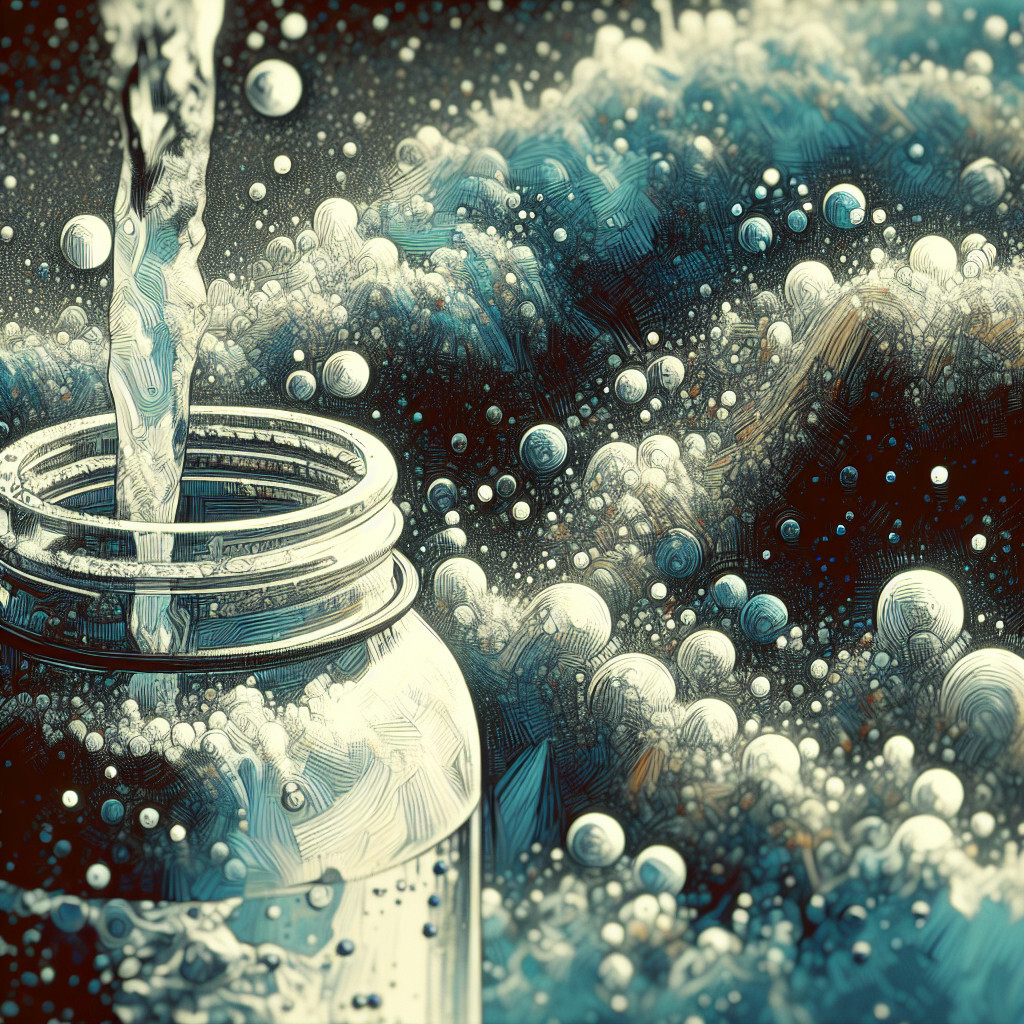-
Table of Contents
“Unveiling the Unseen Purity: A Closer Look at Tap Water”
Introduction

Tap water zoomed in refers to the microscopic examination of tap water, revealing a complex composition beyond its seemingly clear appearance. This analysis uncovers a multitude of microscopic organisms, minerals, and chemical compounds that are invisible to the naked eye. The quality and composition of tap water can vary greatly depending on geographical location and local water treatment processes. This microscopic perspective of tap water provides crucial insights into its safety, purity, and overall quality.
Exploring the Microscopic World of Tap Water
Tap water, a seemingly simple and mundane substance, is in fact a complex and fascinating microcosm teeming with life and activity. When viewed under a microscope, the world of tap water reveals a myriad of microscopic organisms, minerals, and other substances that are invisible to the naked eye. This microscopic world is not only intriguing but also has significant implications for our health and the environment.
The most common inhabitants of the microscopic world of tap water are bacteria. These microscopic organisms are present in virtually all water sources, including tap water. While many of these bacteria are harmless, some can cause diseases such as E. coli and Legionnaires’ disease. Therefore, water treatment facilities employ various methods, including chlorination and ultraviolet light treatment, to kill or deactivate harmful bacteria. However, it’s important to note that not all bacteria can be completely eliminated, and some may still be present in tap water.
In addition to bacteria, tap water also contains a variety of other microscopic organisms. These include algae, protozoa, and even tiny animals like rotifers and copepods. These organisms are part of the natural ecosystem of water and play important roles in the water cycle. For instance, algae produce oxygen through photosynthesis, while protozoa and tiny animals help to break down organic matter.
Minerals are another key component of the microscopic world of tap water. These include calcium, magnesium, and potassium, which are essential for human health. These minerals give water its taste and are the reason why some people prefer the taste of tap water over bottled water. However, excessive amounts of certain minerals, such as lead or copper, can be harmful. Therefore, water treatment facilities also work to maintain the right balance of minerals in tap water.
Furthermore, tap water can also contain microscopic particles of various substances. These can include particles of dust, rust, or even tiny fragments of plastic. These particles can originate from various sources, including the pipes that transport the water, the air, or the water source itself. While most of these particles are harmless, some can pose health risks. For instance, microscopic plastic particles, also known as microplastics, have been found in tap water around the world. These particles can accumulate in the body over time and may have harmful effects.
In conclusion, the microscopic world of tap water is a complex and dynamic ecosystem that is teeming with life and activity. It is a world that is largely invisible to us, yet it has significant implications for our health and the environment. By understanding this microscopic world, we can better appreciate the importance of clean, safe tap water and the challenges involved in providing it. Moreover, it underscores the need for ongoing research and monitoring to ensure the safety and quality of our tap water.
The Hidden Life in Your Tap Water: A Closer Look
Water is a fundamental necessity for life, and in many parts of the world, it is readily available at the turn of a tap. However, have you ever wondered what might be in your tap water when observed under a microscope? The truth is, tap water is teeming with a hidden life that is invisible to the naked eye. This article will take a closer look at the microscopic world that exists in your tap water.
Firstly, it is important to understand that tap water is not just H2O. It is a complex mixture of minerals, gases, organic matter, and microscopic organisms. The exact composition of tap water varies depending on the source of the water and the treatment it undergoes before reaching your tap.
One of the most common microscopic organisms found in tap water is bacteria. Bacteria are single-celled organisms that are essential for the functioning of the Earth’s ecosystems. They play a crucial role in the water treatment process, helping to break down organic matter and other pollutants. However, not all bacteria are beneficial. Some species, such as E.coli and Salmonella, can cause illness if they are present in drinking water.
In addition to bacteria, tap water can also contain tiny organisms called protozoa. These are larger than bacteria and can sometimes be seen without a microscope. Some protozoa, like Giardia and Cryptosporidium, are parasites that can cause gastrointestinal illness if they are ingested.
Another group of organisms that can be found in tap water are algae. Algae are plant-like organisms that produce oxygen through photosynthesis. They are usually harmless, but in large numbers, they can cause problems such as taste and odor issues in drinking water.
It’s also worth noting that tap water can contain microscopic animals. These include tiny crustaceans called copepods and rotifers, which are microscopic animals that feed on bacteria and other small particles. While the thought of drinking water filled with tiny animals might be off-putting, these organisms are generally harmless and can even be beneficial by helping to keep the water clean.
While the presence of microscopic life in tap water might seem alarming, it’s important to remember that most of these organisms are harmless and some are even beneficial. Water treatment processes are designed to remove harmful organisms and ensure that the water is safe to drink. However, these processes are not perfect, and some organisms can slip through the cracks.
In conclusion, tap water is a fascinating microcosm of life that is largely invisible to the naked eye. It is a complex mixture of minerals, gases, organic matter, and microscopic organisms that play a crucial role in our world’s ecosystems. While some of these organisms can cause illness, most are harmless and some are even beneficial. So, the next time you turn on your tap, take a moment to appreciate the hidden life that exists in every drop of water.
Zooming in on the Quality of Tap Water: What’s Really There?
Tap water is a fundamental resource that we often take for granted. It is a staple in our daily lives, used for drinking, cooking, cleaning, and bathing. However, have you ever stopped to consider what’s really in your tap water? When we zoom in on the quality of tap water, we find a complex composition that can vary greatly depending on geographical location, treatment methods, and source of water.
Water, in its purest form, is a simple molecule composed of two hydrogen atoms and one oxygen atom. However, tap water is far from pure H2O. It contains a variety of dissolved substances, including minerals, gases, and potentially harmful contaminants. These substances can significantly impact the taste, smell, and safety of your tap water.
Minerals are a common component of tap water. Calcium, magnesium, and potassium are often present, contributing to the “hardness” or “softness” of the water. These minerals are not harmful to health; in fact, they can contribute to our daily mineral intake. However, high levels can lead to scale buildup in pipes and appliances, affecting their efficiency and lifespan.
Gases such as oxygen and carbon dioxide are also dissolved in tap water. These gases can affect the taste and odor of the water. For instance, water with a high concentration of dissolved oxygen often tastes fresher, while water with excess carbon dioxide can taste slightly sour.
However, it’s the potential presence of harmful contaminants that raises the most concern. These can include bacteria, viruses, heavy metals, pesticides, and other chemical pollutants. Many of these contaminants come from human activities such as agriculture, industry, and waste disposal. They can infiltrate water sources and pose significant health risks if consumed in large amounts over time.
To ensure the safety of tap water, most municipalities treat their water supply to remove harmful contaminants. Common treatment methods include coagulation and flocculation, sedimentation, filtration, and disinfection. These processes are designed to remove particles, kill bacteria and viruses, and eliminate harmful chemicals. However, no treatment method is 100% effective, and some contaminants may still remain in the water.
In addition, some treatment methods can introduce new substances into the water. For instance, chlorine is often used to disinfect water, but it can react with organic matter to form potentially harmful byproducts. Fluoride is also commonly added to tap water to promote dental health, but its use is controversial due to potential health risks associated with high levels of fluoride.
The quality of tap water can also be affected by the condition of the water distribution system. Old, corroded pipes can leach lead into the water, while biofilm buildup can harbor bacteria. Therefore, even if the water leaves the treatment plant in pristine condition, it can still pick up contaminants on its way to your tap.
In conclusion, tap water is a complex mixture of substances, some beneficial and some potentially harmful. Its quality can vary greatly depending on many factors, including the source of water, treatment methods, and condition of the distribution system. Therefore, it’s important to regularly test your tap water, especially if you rely on it for drinking and cooking. By zooming in on the quality of tap water, we can better understand what we’re really consuming and take steps to ensure its safety.
The Science Behind Tap Water: A Microscopic Examination
Tap water, a seemingly simple and mundane substance, is actually a complex and fascinating entity when examined under the microscope. This article delves into the science behind tap water, providing a microscopic examination that reveals its intricate composition and the processes it undergoes before reaching our faucets.
Water, in its purest form, is composed of two hydrogen atoms bonded to one oxygen atom, forming a molecule known as H2O. However, tap water is far from pure H2O. It contains a myriad of other substances, including minerals, gases, and even microorganisms. These additional components are not necessarily harmful; in fact, many of them are essential for our health. For instance, minerals like calcium and magnesium contribute to the nutritional value of tap water.
The journey of tap water begins at a source, which could be a river, lake, or underground aquifer. From there, it is transported to a treatment plant where it undergoes several processes to ensure its safety and potability. Initially, the water is subjected to coagulation and flocculation, where chemicals are added to bind with dirt and other particles, forming larger clumps known as flocs. These flocs then settle at the bottom of the water supply during the sedimentation process.
Following sedimentation, the water is filtered to remove any remaining particles. This filtration process can involve sand, gravel, and charcoal, each serving a unique purpose. Sand is effective in trapping larger particles, while activated charcoal can adsorb organic compounds and chlorine. The final step in the treatment process is disinfection, where substances like chlorine or ultraviolet light are used to kill any remaining bacteria or viruses.
Despite these rigorous treatment processes, tap water can still contain trace amounts of various substances. These can include minerals, salts, metals, and even microorganisms. However, these are typically present in such small quantities that they pose no health risk. In fact, the presence of certain minerals can actually enhance the taste of the water and provide nutritional benefits.
Under the microscope, tap water reveals a fascinating world. Tiny bubbles of dissolved gases like oxygen and carbon dioxide can be seen. These gases are vital for aquatic life and also play a role in the water’s taste. Minerals, too, can be observed as tiny particles suspended in the water. These can include calcium, which contributes to the hardness of water, and iron, which can give water a reddish hue.
Microorganisms are another component that can be found in tap water. These can include bacteria, algae, and even tiny animals like copepods. While the thought of microorganisms in our water may be unsettling, it’s important to note that most of these are harmless. In fact, some bacteria play a crucial role in breaking down organic matter in the water.
In conclusion, tap water is a complex mixture of H2O, minerals, gases, and microorganisms. It undergoes rigorous treatment processes to ensure its safety and potability. Under the microscope, it reveals a fascinating world that is largely invisible to the naked eye. So, the next time you fill a glass from the tap, take a moment to appreciate the intricate science that ensures the water is safe and healthy to drink.
Q&A
1. Question: What are the tiny particles visible when tap water is zoomed in?
Answer: The tiny particles visible when tap water is zoomed in could be minerals such as calcium and magnesium, or impurities like dust or microorganisms depending on the water quality.
2. Question: Why does tap water appear clear when not zoomed in?
Answer: Tap water appears clear when not zoomed in because the particles and minerals present are too small to be seen by the naked eye.
3. Question: Can harmful bacteria be seen in tap water when zoomed in?
Answer: Yes, harmful bacteria can potentially be seen in tap water when zoomed in, but it would require a powerful microscope, as most bacteria are too small to be seen with the naked eye or a standard magnifying device.
4. Question: What is the significance of seeing air bubbles when tap water is zoomed in?
Answer: Seeing air bubbles when tap water is zoomed in indicates that the water was recently agitated or pressurized, which causes dissolved air to form visible bubbles.
Conclusion
Upon zooming in on tap water, it can be concluded that it is not just simple H2O. It contains various other elements and compounds including minerals like calcium and magnesium, gases like oxygen, and potentially harmful contaminants like lead or bacteria. The quality and composition of tap water can greatly vary depending on the geographical location and the source of the water.






